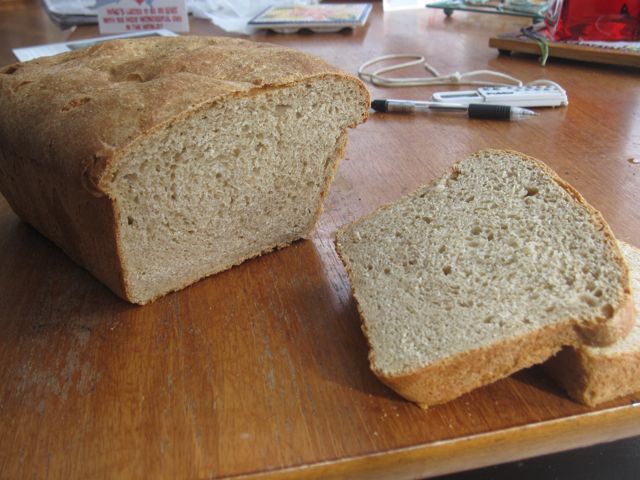
Home milled brioche -- SUCCESSS!

I wanted to make brioche from whole grains and I wanted it to rise really, really well.
I have found thanks to TFL and also to Reinhart's book that it is really important to 1) pre-ferment, and 2) do a soaker, for autolysing. I don't measure so I use my judgment when I bake. I'm that kind of baker.
The formula would be something like this. About 3C of a mixture of red winter wheat and white winter wheat, milled as fine as possible in my Fidibus stone grinder. About 1/2 C of white flour that I would eliminate the next time and replace with more home milled flour.
2 eggs
1 stick of butter (16 tablespoons), high fat European butter, smashed a bit to soften it but straight out of the refrigerator
1.5 teaspoons of salt
2 tablespoons honey
1/8th tspoon of IDY, then a further 1 tspon
Hydration to about 55% I would guess, using water, with the remaining coming from the eggs, the honey, and the butter that all contain water
I didn't want my brioche dough to be too slack so I used about a cup of flour and a scant 1/8th teaspoon of IDY and let it sit for about 24 hours as a biga. I also made a soaker with 2C of flour and 1/2 teaspoon salt so it was not quite fully hydrated and left it covered for the same amount of time. There was some dry flour visible and not enough water to make it congeal into a ball. I wanted the further hydration neededto come from the added ingredients.
After 24 hours, I mixed the soaker and the biga in a food processor. I like the food processor for this. I added two eggs, the remaining salt, and the honey and the rest of the IDY. Then I added the butter. At this point the hydration was too much and the dough resembled a sticky batter. I added 1/2 cup of flour, this was King Arthur bread flour as I didn't want to grind any more and I had run out of home milled flour and was too lazy to grind more :)
Now I took it out of the processor and did a few stretch and folds. Then I got it into a ball and refrigerated it for about 6 hours. When I removed it, it had risen nicely. I folded it and put it in the loaf pan and let it rise for probably too long, but I was out and about. About 8 hours actually. It had risen to the point where it almost overflowed the loaf pan.
I baked it at 350F to start with, 18 minutes, then down to 300F for about 40 minutes. It is my experience that lower temperatures and longer cooking times ensure the bread isn't gummy, as bread made from home milled flour tends to become overly hydrated and you have to bake longer to dry it out.
This is the lightest best rising bread. I don't think it's because of the small amount of conventional flour, although it could be. I think it's the soaker, the biga, and the food processor.
Next time I'll have more home milled flour on hand and will do it 100% with home milled flour.
The flavor is very good. The bread isn't too crumbly as sometimes brioche tends to be. You can't taste the egg in it. It has a rich brioche quality with a lot more flavor than a white bread brioche and makes magnificent toast.


that is wonderful!
The keys to home milled flour are hydrating the dough first, with a bit of salt, and pre-fermenting. This is the first time I've used the food processor and maybe it will turn out that this helps as well. I'll keep you posted.